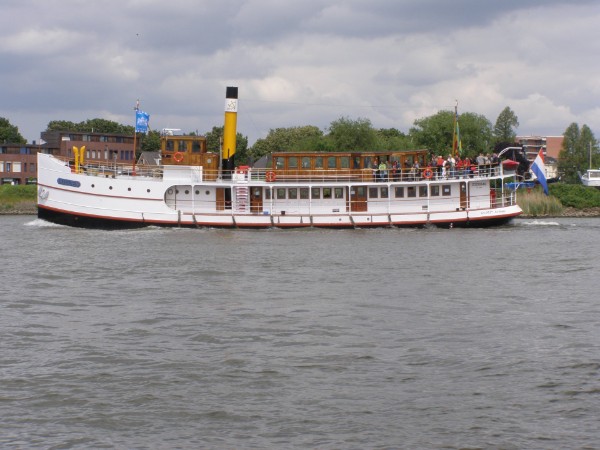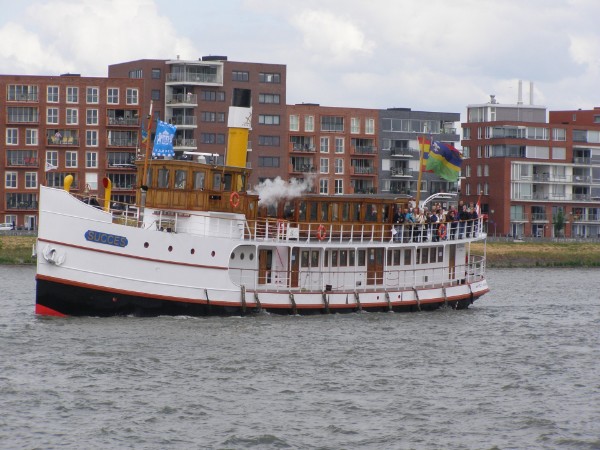Succes
The Succes was, although her appearance now is that of a classic passenger-salonboat, built as a rhine-steamtug at the P. Boele wharf at Slikkerveer, The Netherlands in 1897. She was one of the largest and strongest rivertugs afloat in The Netherlands, when she was built. Her engine was built at the Huiskens en Van Dijk engineering company and the ship started her working life for Adriaan Van Dordt, based at Rotterdam. She was bought by the Nederlandse Transport Maatschappij (Dutch Transport Company) in 1916 and was renamed Sleipnir for this company. The ship kept working within this company untill 1952, when she was sold to the Nederlandse Rijnvaart Vereniging (Dutch Rhine Company). Both of these companies were based at Rotterdam and used the Sleipnir as a tug at the Rhine river between Rotterdam and Basel, Switzerland.
Below is Succes at the Dordt in Stoom festival at Dordrecht, The Netherlands in 2008. She looks a lot different from when she was built as a steamtug in 1897.

In 1957, her tugservices at the Rhine ended and the ship was rebuilt as a tanker-cleaner for the Vacuüm Cleaning company from Rotterdam. For this, the ship was renamed Succes 1. She also recieved a new engine and she was reverted from a coal-burner to an oil-burner. She provided this service untill 1973, when she was sold for scrap and sailed for the ovens at the Rijsdijk Scrapyard at Hendrik Ido Ambacht in The Netherlands. Her rusty hulk was not scrapped though, it layed idle at the scrapyard untill 1985, when the remains of the hull were sold to Joop Mos, inhabitant of the village of Enkhuizen. He found some partners to restore the ship to a new life and the rebuilding took untill 1994. The original hull was scrapped up to the waterline and she emerged as the biggest and oldest passenger salon-steamer in the Netherlands. Her bow was heightened and she recieved a second deck and, although she was built to look like a classic vessel, she recieved the most modern safety features so she could be certified to sail with passengers. The new look for the ship was based on the design of the Bosman, a ferry that sailed a service between Enkhuizen and Stavoren at the inland sea Zuiderzee in the Netherlands between 1915 and 1936. The interiours of the Succes are very classical, because of the use of copper, crystal, teak and lether. The last surviving chandelier from the first class lounge of the 1947-built Rotterdam Lloyd oceanliner Willem Ruys (later Achille Lauro) is one of the centerpieces of the Succes.

The Succes is in Holland very well known, especially because she is the most notable musician in the fleet of steamships. On board, she has the largest steam-organ in Europe and she plays a lot of songs while sailing that can be heared from miles distance. Because of this, she is used by fleshy musicians, soundartists, and producers of films, commercials and documentaries. Next to this, the ship is allowed to host weddings on board and she is a very popular place to do so.
The ship can sail with up to 110 passengers and is allowed to sail inland waterways including large rivers, like up the Rhine on to Switzerland. Her lenght is 38,5 meters, she is 7,15 meters wide, a draft of 2,15 meters and she has a water-displacement of 369,194 cubic meters.

